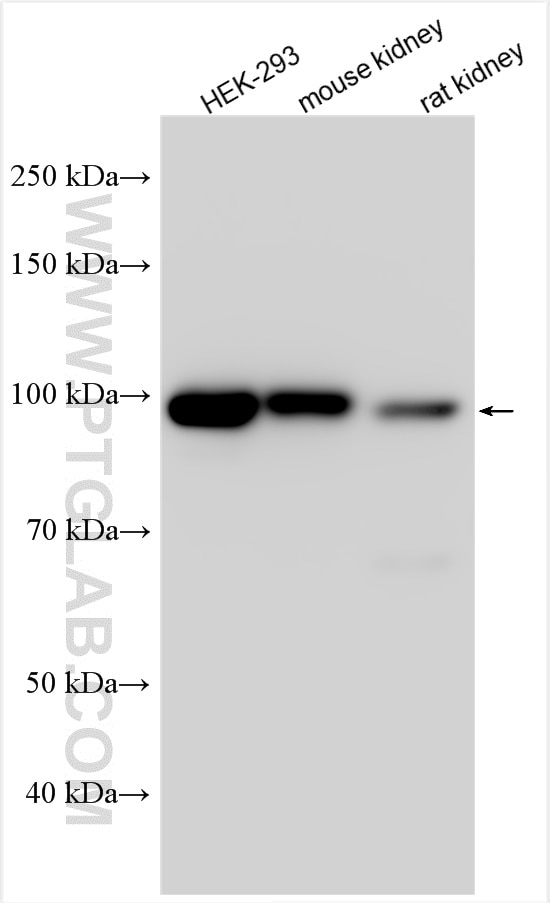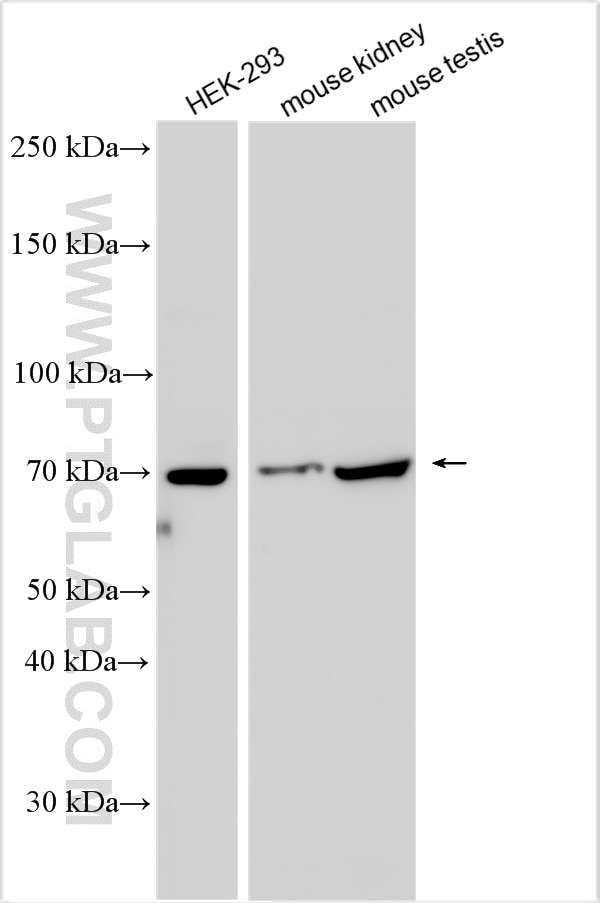SLC26A7 Polyklonaler Antikörper
SLC26A7 Polyklonal Antikörper für WB, ELISA
Wirt / Isotyp
Kaninchen / IgG
Getestete Reaktivität
human, Maus, Ratte
Anwendung
WB, ELISA
Konjugation
Unkonjugiert
Kat-Nr. : 17654-1-AP
Synonyme
Geprüfte Anwendungen
| Erfolgreiche Detektion in WB | HEK-293-Zellen, Mausnierengewebe, Maushodengewebe, Rattennierengewebe |
Empfohlene Verdünnung
| Anwendung | Verdünnung |
|---|---|
| Western Blot (WB) | WB : 1:500-1:2000 |
| It is recommended that this reagent should be titrated in each testing system to obtain optimal results. | |
| Sample-dependent, check data in validation data gallery | |
Produktinformation
17654-1-AP bindet in WB, ELISA SLC26A7 und zeigt Reaktivität mit human, Maus, Ratten
| Getestete Reaktivität | human, Maus, Ratte |
| Wirt / Isotyp | Kaninchen / IgG |
| Klonalität | Polyklonal |
| Typ | Antikörper |
| Immunogen | SLC26A7 fusion protein Ag11901 |
| Vollständiger Name | solute carrier family 26, member 7 |
| Berechnetes Molekulargewicht | 656 aa, 72 kDa |
| Beobachtetes Molekulargewicht | 72 kDa |
| GenBank-Zugangsnummer | BC094730 |
| Gene symbol | SLC26A7 |
| Gene ID (NCBI) | 115111 |
| Konjugation | Unkonjugiert |
| Form | Liquid |
| Reinigungsmethode | Antigen-Affinitätsreinigung |
| Lagerungspuffer | PBS with 0.02% sodium azide and 50% glycerol |
| Lagerungsbedingungen | Bei -20°C lagern. Nach dem Versand ein Jahr lang stabil Aliquotieren ist bei -20oC Lagerung nicht notwendig. 20ul Größen enthalten 0,1% BSA. |
Hintergrundinformationen
SLC26A7, Anion exchange transporter, belongs to sulfate/anion transporter family. SLC26A7 acts as a sodium-independent DIDS-sensitive anion exchanger mediating bicarbonate, chloride, sulfate and oxalate transport. It plays a role in the maintenance of the electrolyte and acid-base homeostasis in the kidney, by acting as a distal excretory segment-specific anion exchanger (PMID: 11834742, PMID: 12736153). SLC26A7 mutations is associated with thyroid dyshormonogenesis (PMID:29546359).
Protokolle
| PRODUKTSPEZIFISCHE PROTOKOLLE | |
|---|---|
| WB protocol for SLC26A7 antibody 17654-1-AP | Protokoll herunterladen |
| STANDARD-PROTOKOLLE | |
|---|---|
| Klicken Sie hier, um unsere Standardprotokolle anzuzeigen |



